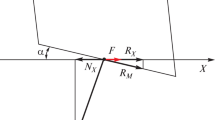Abstract
By introduction of an interstand tension in the order of 10% of the actual yield stress of the rolled material in the intermediate stage of wire rod rolling, it is possible to increase the intermediate reductions without excessive increase of energy supply for rolling. Thus, an eight passes finishing block can be replaced by two intermediate stands and a four stand finishing block of a module type. This configuration gives two improvements on the productivity in a wire rod mill for stainless steel. First, the finish rolling speed can be increased from typically 60 m/s up to 80 m/s, meaning 33% higher rolling rate. Second, the modern twin module block system gives the possibility to introduce a single family rolling system, which gives a reduction of the downtime for roll and groove changing in the order of 20% of the production time, depending on the product mix in the mill.
Zusammenfassung
Durch Einführen eines 10%igen Längszugs im Knüppel während des Streckwalzens ist es mögllich, die Dickenabnahmen ohne Erhöhung des Energieverbrauchs zu vergrößern. So kann ein achtgerüstiger Fertigblock ersetzt werden durch zwei Zwischengerüste und einen viergerüstigen Fertigblock. Durch eine solche Anordnung lassen sich Produktivitätsverbesserungen des Walzwerks erzielen: Erstens kann die Endwalzgeschwindigkeit von typischen 60 m/s auf 80 m/s erhöht werden, was ein 33%ige Erhöhung der Walzleistung bedeutet. Zweitens eröffnet der moderne Endwalzblockmodul die Möglichkeit, eine einzige Kaliberfamilie zu installieren, wodurch sich eine Totzeitverminderung von 20% beim Walzenwechsel erzielen lässt.
Similar content being viewed by others
References
Eriksson, C.: Working range for series and sequences of two-symmetrical grooves in wire rod mills. Submitted in October 2003 to Journal of Materials Processing technology for publication.
Collin, B.: Spårseriens Utformning och Reduktionsförmåga vid Varmvalsning av Tråd med Konstant Valsningsgeometri. (Design and reduction capability of roll pass sequences in hot rolling of wire rod with constant rolling geometry). Jk 314/69, Jernkontoret, Stockholm (1969). (In Swedish).
Bergström, R., and N.-G. Malmgren: Arbetsområde för Spår vid Trådvalsning (Working range for grooves in wire rod rolling). Jk 314/69, Jernkontoret, Stockholm (1971). (In Swedish).
Wallner, G.: Flexibilitet vid Valsning av Stång och Tråd” (Flexibility in rolling of bar and wire rod). Ph D Thesis in Metals Working, The Royal Institute of Technology, Stockholm (1976). (In swedish).
Albrecht, P.: Utveckling av Flexibel Spårserie för Stång- och Trådvalsning (Development of a flexible roll pass sequence for bar and wire rod rolling). Ph D Thesis in Metals Working, The Royal Institute of Technology, Stockholm (1977). (In Swedish).
Nyström, A.: Arbetsområde och Stabilitet vid Spårvalsning (Working range and stability in rolling in grooves). Ph D Thesis in Metals Working. The Royal Institute of Technology, Stockholm (1980). (In Swedish).
Eriksson, C.: Arbetsområde för Spår—Del III (Working range for grooves—Part III) Jernontorets Forskning B 553, Jernkontoret, Stockholm (1983). (In Swedish).
Eriksson, C.: Surface cracks in wire rod rolling. Steel Research International, Vol. 75 (2004), No 12, 818–828.
Seger, U.: Dragspänningar och Dimension-stoleranser vid Valsning i Trådblock” (Interstand tensions and dimensional tolerances by rolling in wire rod blocks). Ph D Thesis in Metals Working, The Royal Institute of Technology, Stockholm (1981). (In Swedish).
Eriksson, C., andS.-E. Lundberg: Working range of roll pass sequences in wire rod rolling with interstand tensions. Ironmaking and Steelmaking31 (2004), 81–92.
Lundberg, S.-E.: Development trends in high productivity hot rolling of high quality high carbon steel wire rod. BHM147 (2002) 333–344.
Börjesson, A.: Inre Struktur hos Varmvalsad Rostfri Tråd — Speciellt Uppkomsten av Porositeter i Trådens Centrum (Internal structure of hot rolled stainless wire rod — especially the formation of centre porosities in the rod). MSc Thesis at the Royal Institute of Technology, Department of Physical Metallurgy. Fagersta Stainless AB, Fagersta 2003. (In Swedish).
Lestani, M., andS.-E. Lundberg: Modern technologies for the production of superior quality stainless steel wire rod. MPT —Metallurgical Plant and Technology International23 (2000), 78–90.
Lundberg, S.-E: Evaluation of roll surface temperature and heat transfer in the roll gap by temperature measurements in the rolls. Scandinavian Journal of Metallurgy26 (1997), 20–26.
Lundberg, S.-E: The revenge of the three high rougher. Accepted in July 2004 for publication in Stahl und Eisen.
Shore, T. M., B. V. Kiefer and J. C. Vincent: Modernization of high speed rod mills to achieve increased productivity, mill utilization and thermomechanical processing. Proc. of 3rd European Rolling Conference, VDEh, Düsseldorf (2003), 249–254.
Klarin, K., J.-P. Mouton andS.-E. Lundberg: Application of computerized slip line field analysis for the calculation of lever arm coefficient in hot rolling mills. Journal of Materials Processing Technology36 (1993), 427–446.
Oehistöter, G., andU. Franke: Mechanismen des Flächenfehlerabbaues beim Walzen von Stabstahl und Draht. BHM130 (1985), 74–79.
Kutzsche, K., andG. Oehlstöter: Beeinflussung der Umformverhältnisse in Walzblöcken unter besonderer Berücksichtigung des Längszugs. Neue Hütte34 (1989), 327–331.
Oehlstöter, G. andI. Jäckel: Einfluss des Längszuges beim Kontiwalzen auf Form und Maßhaltigkeit von Stäben und Drähten, Stahl und Eisen112 (1992) 53–60.
Mauk, P. J.: Analysis of interacting influencing parameters of wire rod and bars in the rolling process. Proc. of 2nd European Rolling Conference “Rolling 2000” Västerås 2000, Jernkontoret, Stockholm (2000), on CD-ROM.
Recalcati, C.: Cinquant’anni di evoluzione technologico della laminazione a caldo del filo e del tondi in rotoli ed in barre. (Fifty years of technological development in the hot rolling of wire rod and rounds in coils and bars). La Metallurgia Italiana10 (1997), 23–29. (In Italian).
Perä, J.-O. andS.-E. Lundberg: Application of computer simulations to low-temperature wire rod and bar rolling, Iron and Steel Engineer, Nov (1985) 48–52.
Lundberg, S.-E.: A model for shape control in bar mills. Proc. of 1st International Conference on Modelling of Metal Rolling Processes, Sept 21–23, 1993, The Institute of Materials, London (1993).
Author information
Authors and Affiliations
Rights and permissions
About this article
Cite this article
Lundberg, S.E., Eriksson, C. Ultra high speed rolling of stainless steel wire rod by means of interstand tensions. Berg Huettenmaenn Monatsh 150, 5–11 (2005). https://doi.org/10.1007/BF03165142
Issue Date:
DOI: https://doi.org/10.1007/BF03165142




